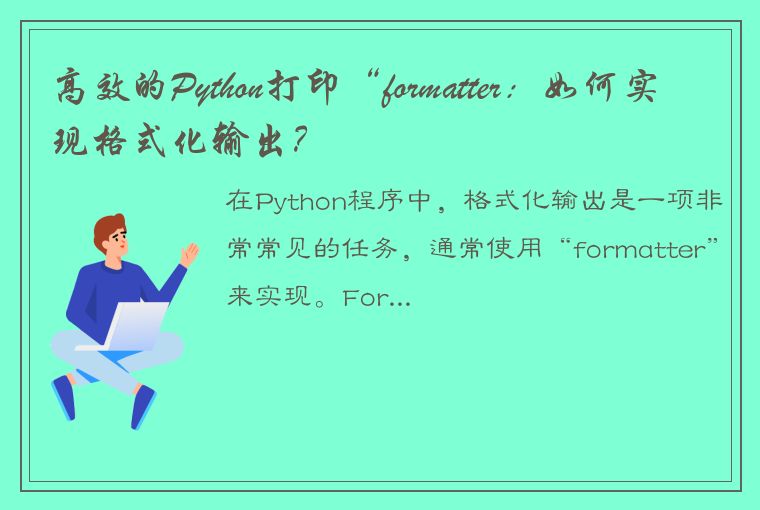在Python程序中,格式化输出是一项非常常见的任务,通常使用“formatter”来实现。Formatter是Python的一种格式化工具,它允许我们使用特定符号格式化字符串中的数据。本文将介绍Python中如何使用formatter来生成高效的输出。

I.基本使用
Python中的formatter可以使用“%”运算符。与其他的编程语言一样,格式化字符串中的特定符号会被替换为数据。这里是一些示例:
1.基本的字符串格式化
我们可以通过“%s”占位符将一个字符串插入到另一个字符串中。例如,这段代码将生成“Hello, world!”:
```
print("Hello, %s!" % "world")
```
输出:Hello, world!
其中,“%s”的意思是将字符串插入。即表示任何字符类型。我们可以在占位符中加入多个参数,以逗号分隔。例如:
```
print("%s is %d years old." % ("Tom", 28))
```
输出:Tom is 28 years old.
注意,这里我们使用了“%d”占位符,表示数字类型。
2.格式化整数
我们可以使用“%d”占位符将整数插入到字符串中。例如:
```
print("Today is the %dth day of the year." % 171)
```
输出:Today is the 171th day of the year.
也可以将十六进制数表示为字符串:
```
print("The answer is %x" % 42)
```
输出:The answer is 2a
3.格式化浮点数
我们可以使用“%f”占位符将浮点数插入到字符串中。例如:
```
print("The value of pi is approximately %f." % 3.14159)
```
输出:The value of pi is approximately 3.141590.
这里,“%f”表示浮点数占位符,它可以通过“%.”来指定小数位数:
```
print("The value of pi is approximately %.2f." % 3.14159)
```
输出:The value of pi is approximately 3.14.
II.高效的格式化
上面介绍的方法可以让我们实现基本的格式化,但是如果有大量的数据需要格式化,这种方式就显得有些低效了。为了解决这个问题,Python提供了另一种格式化方法:字符串.format()方法。
1.基本语法
字符串.format()方法的基本语法为:
```
"{} is {} years old.".format("Tom", 28)
```
输出:Tom is 28 years old.
这种方式非常灵活,可以自由指定数据的输出位置,看下面的代码:
```
name = "Tom"
age = 28
print("{1} is {0} years old.".format(age, name))
```
输出:Tom is 28 years old.
稍微复杂一些,可以通过字典来处理数据:
```
data = {"name": "Tom", "age": 28}
print("{name} is {age} years old.".format(**data))
```
输出:Tom is 28 years old.
2.格式化说明符
字符串.format()方法还提供了格式化说明符,可以更好的控制输出。
2.1.指定数据类型
我们可以在格式化字符串后添加一个“:”来指定变量的数据类型。例如:
```
print("The answer is {:d}.".format(42))
```
输出:The answer is 42.
这里,“d”表示输出类型为整型。
2.2.设置小数位数
我们可以通过“.”来指定小数位数:
```
print("The value of pi is approximately {:.2f}.".format(3.14159))
```
输出:The value of pi is approximately 3.14.
这里,“.2”表示保留两位小数。
2.3.指定填充字符
我们可以在格式化字符串后加上一个宽度和填充字符,例如:
```
print("{:*^20}".format("Tom"))
```
输出:*******Tom********
这里,“^”表示居中对齐,“20”表示宽度,使用“*”来填充空缺。
2.4.使用参数
另一种强大的方式是在字符串.format()方法的参数中直接使用格式化符号:
```
print("{item.upper()} is {price:.2f} dollars.".format(item = "apple", price = 0.25))
```
输出:APPLE is 0.25 dollars.
这里,“.2f”表示保留两位小数,而“upper()”是Python字符串的内置方法,表示将字符串转化为大写。
III.结语
Python中的formatter是一个功能强大的工具,可以将程序输出变得更加简单明了。使用这种方法,不仅可以更好地控制输出,而且还可以提高程序的效率。希望本文能够帮助读者更好地了解Python中的formatter,为编写更优美的代码提供一些帮助。




 QQ客服专员
QQ客服专员 电话客服专员
电话客服专员